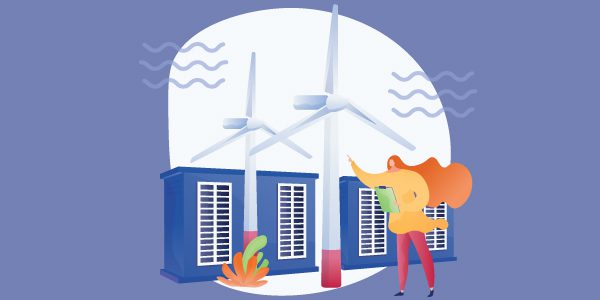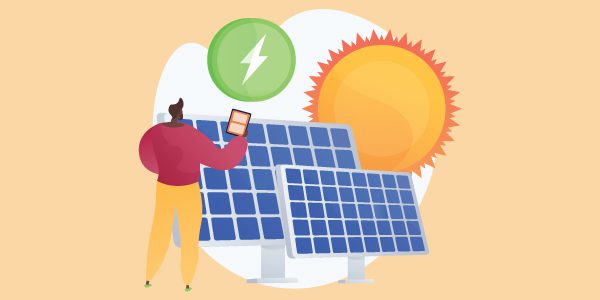Wind Power generation has grown immensely in Australia since the 1980s. In fact, it remains the largest renewable energy source in the country.
Australia as a whole is well equipped to produce wind energy particularly in the southwest of Western Australia, southern South Australia, western Victoria, northern Tasmania and the elevated areas of New South Wales and Queensland.
Whilst the industry is on the rise in Australia, the country is still lagging behind countries like Denmark, where forty percent of their total electricity is generated from wind compared to Australia’s eight percent. However, Australia has the potential to turn into a wind superpower.
What Is Wind Energy & How Does It Generate Power?
Wind energy is a type of solar energy that results from changing air temperature and pressure. Wind energy converts the kinetic energy of wind into electric energy through the use of wind turbines.
A wind turbine is made up of four main parts, the base, the tower, generator and the blades.
Kinetic energy from the wind forces the blades of the turbine to turn, thus causing a series of gears that are connected to the electric generator to spin. The generator then converts the wind energy into electricity.
Utility-scale wind turbines come in different capacities depending on the application. They can range from a few hundred kilowatts which are used for residential use, to several hundred megawatts used for commercial application. The amount of energy that is produced depends on the size of the turbine and the weather conditions.
Growth Of The Wind Market In Australia
Wind turbine-generated power has been around in Australia for decades. Yet wind power generation on a utility-scale didn’t reach Australia’s shores until the late 1980s.
In the following decades, wind farm construction continued to grow slowly. The 2000s brought in a much larger wave of new projects with much larger generation capacity.
Nowadays wind energy is one of Australia’s main sources of renewable energy, generating enough energy to meet 35.9 percent of the country’s electricity demands and 9.9 percent of Australia’s overall electricity supply.
The Australian states leading the way are Tasmania, which has a capacity factor of 80%, Western Australia and North Queensland (55%), followed by South Australia and New South Wales (45%).
In 2020 the wind sector added more than 1 GW of new capacity, making it the second consecutive year in a row.
Wind is also one of the cheapest sources of electricity in Australia, along with utility-scale solar PV.
With new wind farms expected to deliver electricity at $50-65/MWh in 2020, prices are expected to fall below $50/MWh by 2030.
By 2030, the wind industry is planning to have 50 percent of the share of electricity generation in Australia. This is an ambitious goal that is likely to present a massive opportunity to players that are involved in the Wind Energy sector or thoses who are planning to be involved in the future.
In Australia, there have been more wind farm projects in 2021 than ever before. These include four mega projects with energy systems between 180 – 228 turbines. There are 60 wind projects planned for the next 5 years that will be a total value of $33 billion.
New South Wales, Queensland, Victoria and South Australia are the states that are investing the most in the sector and because of this have the majority of the large scale projects / farms.
- Coopers Gap Wind Farm (QLD)
- Golden Plains Wind Farm (VIC)
- Lake Bonney Wind Farm (SA)
- Liverpool Range Wind Farm, (NSW)
Offshore Wind Farms in Australia
Offshore wind is increasing around the globe. In fact, the International Energy Agency is viewing offshore wind as one of the big three sources of clean energy alongside solar or onshore wind.
The wind conditions on the Australian coast make it the ideal location for offshore wind farms. New research has found that Australia has a very high abundance of offshore wind resources close to existing transmission grids. This allows Australia to have the potential to both harness electricity for generation and create jobs across the country.
More than 2,000GW could be potentially installed within 100km of the current substations, which excludes the environmental restrictions and low wind areas.
The report located offshore sites in Queensland, NSW, Victoria, Tasmania, South Australia and West Australia that would make excellent sites. It also located more critical sites for energy generation in Newcastle, Gippsland and Gladstone where there are strong offshore winds.
There are currently more than ten offshore wind projects sitting in the pipeline waiting for approval in Australia.
Offshore wind in Australia also has the potential to be much larger than onshore wind and solar, up to 2GW for a project, and could generate more electricity per megawatt of capacity.
Some of Australia’s Offshore Wind farms;
Australia still has a long way to go to catch up to the rest of the world’s major players. But, with the vast growth of the industry and the high volume of projects waiting to be approved, the country has the potential to be an industry leader.
As Australia invests more in both Offshore and Onshore wind projects, it will bring higher capacity factors, a diverse energy supply that complements solar, as well as more employment opportunities.











